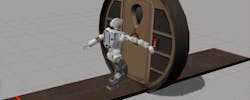Top 20 Space Robotics Challenge teams selected for NASA competition
In partnership with Space Center Houston and NineSigma, NASA has selected the top 20 teams in the Space Robotics Challenge, which tasks teams with developing and displaying the ability of NASA’s Robonaut 5 (R5)humanoid robot to assist in the procedures of a NASA mission, such as one to Mars.
Part of NASA’s Centennial Challenges program, the Space Robotics Challenge is a $1 million prize competition to develop the abilities of the robot dexterity to better enable them to work alongside and independent of astronauts in preparation of future space exploration. The finalists were selected from a pool of 92 teams from 13 countries. The 20 teams selected will be awarded $15,000 and advanced to the finals, which take place in June.
"We are thrilled to have such a huge community of solvers respond to this challenge, and we congratulate the finalists," said Monsi Roman, Centennial Challenges program manager. "The technology they are developing and testing for robotic systems will be essential to helping our human explorers."
In alphabetical order, here are the top 20 teams:
- BIT PLEASE - Cypress, TX, USA
- Coordinated Robotics - Newbury Park, CA, USA
- Mingo Mountain Robotics - Kettle Falls, WA, USA
- MITs - Tokyo, Japan
- Mystic - The Woodlands, TX, USA
- Nevermore - Jersey City, NJ, USA
- Ring of the Nibelungs - Medford, MA, USA
- Sirius - South Hadley, MA, USA
- SpaceBucs - Pittsburgh, PA, USA
- Space Weavers - San Jose, CA, USA
- Team AL v.2.0 - Toronto, ON, Canada
- Team Olympus Mons - Barcelona, Spain
- Team Olrun - Evansville, IN, USA
- THE HUMANZ ARE DEAD - Boston, MA, USA
- Walk Softly - Erie, PA, USA
- Whalers - Nantucket, MA, USA
- Worcester Polytechnic Institute Humanoid Robotics Lab – Worcester, MA, USA
- WV Robotics Team – Fairmont, WV, USA
- Xion Systems – Fresno, CA, USA
- ZARJ – St. Paul, MN, USA
The final part of the competition is held in a virtual environment in Gazebo robot simulation software, where teams must program a virtual robot modeled after the R5 robot, to complete a series of tasks in a simulation that includes periods of latency to represent the communications delay from Earth to Mars, according to NASA. Each team’s robot is tasked with resolving the aftermath of a dust storm that has damaged a Martian habitat involving three objectives: aligning a communications dish, repairing a solar array, and fixing a habitat leak.
NASA’s R5 robot features a head-mounted MultiSense-SL 3D data sensor package, which is comprised of a Hokuyo UTM-30LX-EW laser and a Carnegie Robotics MultiSense S7 stereo camera. The camera is fitted with either a 2 MPixel CMV2000 or 4 MPixel CMV4000 CMOS image sensor from CMOSIS. These sensors feature a Bayer color filter and achieve a maximum frame rate of 30 fps. MultiSense SL also features on-board processing for image rectification, stereo data processing, time synchronizing of laser data with a spindle encoder, spindle motor control, lighting timing, and managing the GigE interface.
NASA’s partners are Space Center Houston, a part of the Manned Space Flight Education Foundation and nonprofit science and space learning center, and NineSigma, which connects organizations with external innovation resources to accelerate innovation in private, public, and social sectors.
View more information on the Space Robotics Challenge.
Share your vision-related news by contacting James Carroll, Senior Web Editor, Vision Systems Design
To receive news like this in your inbox, click here.
Join our LinkedIn group | Like us on Facebook | Follow us on Twitter
Learn more: search the Vision Systems Design Buyer's Guide for companies, new products, press releases, and videos
About the Author

James Carroll
Former VSD Editor James Carroll joined the team 2013. Carroll covered machine vision and imaging from numerous angles, including application stories, industry news, market updates, and new products. In addition to writing and editing articles, Carroll managed the Innovators Awards program and webcasts.
